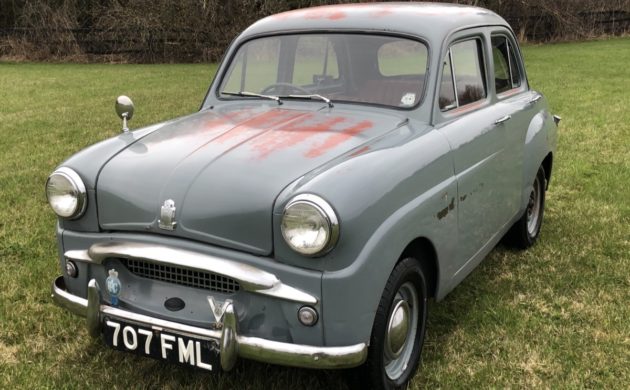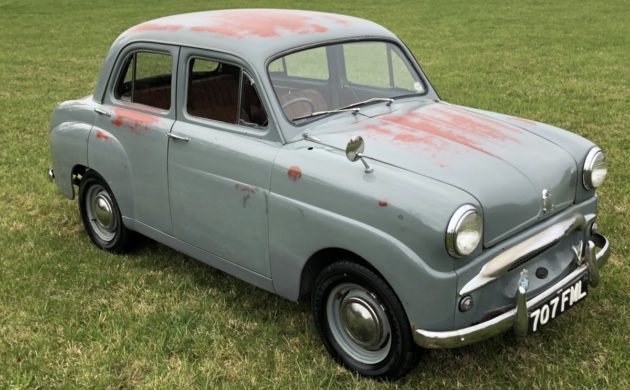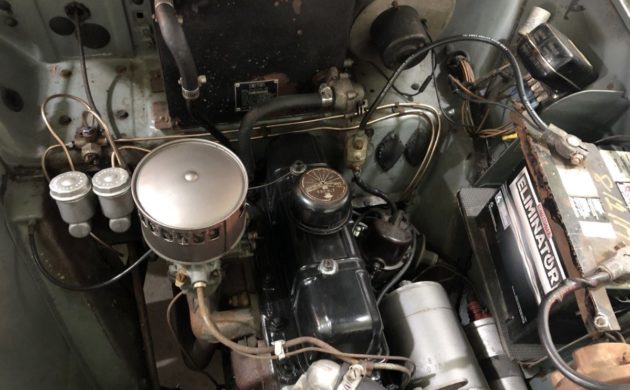While the US emerged from World War II with a strong and vibrant economy, many European nations struggled to recover, with Britain being amongst those that were hardest hit. In a bid to get the country mobile once again, the majority of the country’s car manufacturers put their heads down and produced some remarkable vehicles. With fuel rationing still very much in place, these cars needed to be small and efficient but still had to be capable of transporting a family of four or more as needed. It was against this backdrop that Standard produced the 8, a 4-cylinder 4-door sedan that was capable of seating four people in relative comfort, or five people at a pinch. This particular Standard 8 is a 1955 model and was found hidden away in a barn. It looks as though it had been parked since around 1986, but the owner has put a lot of effort into returning it to a roadworthy and reliable state, and it is now ready to be enjoyed by some lucky buyer. It is located in Queensville, Ontario, Canada, and has been listed for sale here on Barn Finds classifieds. The owner has set the asking price for the little British classic at $12,000.
This little Standard is a great car, and it still wears its original Grey paint. This has worn through to the original red undercoat in a number of places, and the next owner does have the choice of treating the car to a repaint. Personally, I wouldn’t bother. When the owner brought the vehicle out of hiding, he sent it off to a paint restoration specialists. There it was treated to a wet sand, and then to multiple stages of polish. It now has a wonderful wet look about it, and really shouldn’t be prone to any further significant deterioration. The majority of the external trim and chrome is present and remains very presentable. One hubcap does appear to be missing, so it could potentially come down to an eBay search to source a replacement. There are other hubcaps that could be substituted, so this might be an option to consider if the next owner can’t find the correct item. The more observant of you will probably have noticed a lack of an opening trunk lid on the little 8. This isn’t a problem, because the split rear seat folds down to allow access to this area. The split/fold rear seat really didn’t become prominent in regular vehicle production until the early 1980s, so this feature has made the Standard a ground-breaking car of sorts.
The interior of the Standard is showing its age, but it does remain quite presentable. The owner admits that the headliner is beyond help and that the canvas covers on the back sides of the seats are in about the same shape. The seats are upholstered in leather, and this has also become quite dry and cracked. However, the interior does remain serviceable, and in its current state, it does possess a certain amount of character and charm. I guess that the positive news is that if the next owner wants to undertake a full restoration, then it is possible that the existing items could serve as a template to have an upholsterer produce replacement parts. I have to say that it would be tempting to follow this path, although part of me also feels that it would be right and fitting to leave it untouched to reflect its status as an original survivor.
When the Standard 8 was first introduced in 1953, it truly was a new car from top to bottom. Virtually nothing was carried over from its predecessors, and this included the 803cc OHV 4-cylinder engine. This pumped out 26hp, which found its way to the rear wheels via a 4-speed manual transmission. The low power output meant that this was not a fast car by modern standards, with a certified top speed of 60mph. However, with fuel rationing still in place in Britain when this car rolled off the production line, the question of efficiency was far more important. This was the 8’s trump card, because it had no problems achieving consumption figures of 35mpg, while 40mpg was within the reach of any driver who could be light with their right foot. After this Standard 8 was dragged out of hiding, the owner set to work returning it to a roadworthy state once again. This entailed the fitting of new tires and new brakes, along with a number of other components. The effort was worthwhile, as the little British classic now starts easily, and is said to run and drive really nicely.
If you were going to sit down and list ten classic British cars that you would like to park in your garage, I would be willing to bet that a Standard 8 probably wouldn’t be on that list. And you know what? That would be a mistake. While more than 136,000 examples rolled off the production line between 1953 and 1959, the only cars to make it to the USA were privately imported. It isn’t clear what sort of numbers we are talking about here, but an accurate figure would be somewhere around “not very many.” That makes this an interesting and rare vehicle in the US, and if you bought this one and rocked up to your next Cars and Coffee, I can almost guarantee that you would have the only Standard 8 in the place. You would almost certainly also have plenty of people wanting to have a good old chat with you about this little British classic. It’s rare and it’s quirky, and that has to make it a tempting proposition for any enthusiast looking for something a bit special in their next classic car.







And once more… my comment on the missing comment did not show up.
So my third comment appears but where are the first and second? Is it me or is it you?
Paolo, that happened to me too the other day. I posted a comment and it mysteriously disappeared for about a day and then reappeared. Pretty strange.
It’s getting really difficult to own and drive a car with such a modest power output. I sold my Austin America last year due to the fact that it was borderline dangerous to drive it around. People don’t think it is amusing to drive an old underpowered car. They view you as a nuisance and I was constantly harassed by morons who thought it was fun to bully my little car. I now own a Volvo 240 wagon which can keep up with traffic on the highway, is super safe and at least half-way modern even though it is 30 years old.
In the Classifieds Section write up we get another piece of information – there is no trunk lid! Access to the trunk is through the cabin where the rear seats fold down. Wow. This really was a commuter car with an eye towards cheap transportation.
One thing that should be clarified. The car is offered for sale in Ontario, Canada with an ask of $12,000. Would that be $12,000 USD or CDN? It makes a difference as today the exchange is 1.4 so $12,000 CDN is ~$8,544 USD. If you are interested in this little gem it will pay to ask.
One of the reasons early postwar British cars are the way they are is that Britain’s govt decided to cheap out and buy lots of the worst gas on the market and blend it all together. It was called “Pool” gas. It was so low octane that the car makers had to use low compression engines. It would not even run in a Ford flathead v8. Which is why they stuck with 4 and 6 cyl cars.
I thought it was because European cars were taxed on hp. It’s why 3 wheelers became popular, because they got around the car tax. I remember, my old man bought “white” gas. It was cheaper than regular, and had no additives. He started leaf fires with it.
A little over a month late for April 1. An ugly little British austerity car lacking the cute charm of a Ford Pop or Citroen 2CV that looks just old and worn-out. A car nobody in North America ever grew up hoping to own someday. Frankly I find the asking price offensive, not just simply unrealistic.
All the purveyors of negative remarks about this car should note that Sir Stirling Moss raced a Standard 10 saloon during the 1955 Sporting Life Trophy race at Oulton Park where he finished 2nd in class.
Pity you don’t appreciate it. Many do.
Standard actually made some good cars,but I don’t think this is one of thm..They did these as “10” too and a “Pennant”,which had more chrome.The site of the Standard factory at Coventry is today a big retail park.
Cute and rare, but it would certainly be much more desirable to a Brit. Probably costs a fortune to ship a car back to the motherland.
Done right, its cheaper to ship across the ocean than across the country.
Right hand drive, dangerous on an interstate. Sometimes just being cute or unusual isn’t enough.
Right hand drive is no more dangerous on an Interstate than left hand drive on UK Motorways.That said,you wouldn’t take one of these anywhere near one with a top end of about 60 mph!
but RHD is a pain in urban, suburban (tolls, coffee/fast food/bank), parallel park pull outs, which is same in rural which is mostly a passing (2 lane backtop) in the country. I can convert to RHD easily but the roads/otherdrivers/conditions? not so much. Like w/like wrks beddah
my family had a standard 8 for years and a standard 10 for even longer as an around town runabout. Unbreakable little workhorses that you just cannot kill.
Basically the same engine as the later triumph Herald- and early triumph spitfire but not a racing engine….
A face and butt only a mother could love. Even with the conversion to USD, the asking price seems optimistic for something not sought after in the US. As stated earlier, if this was a Popular, Prefect or Zephyr or even an Austin A-30 we’d be in a right good spot for a well-bought door stop.
The last USA carmaker to abandon right hand drive was Pierce Arrow in 1922.A third of the world happily drives on the left.I have 8 LHD cars i use in the UK no problem at all!
I have driven RHD in USA for 35 years. Absolutely no trouble. Drive-through cashiers are amused, not annoyed!